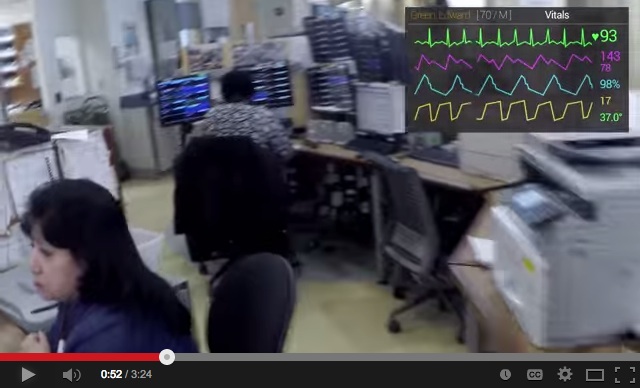 Beth Israel Deaconess Hospital has begun working with a startup called Wearable Intelligence to deploy Google Glass in the emergency department. The hospital has four Glass devices shared among 10 emergency department physicians, including CIO John Halamka, who thinks Glass has the potential to, in some ways, be the new iPad.
Beth Israel Deaconess Hospital has begun working with a startup called Wearable Intelligence to deploy Google Glass in the emergency department. The hospital has four Glass devices shared among 10 emergency department physicians, including CIO John Halamka, who thinks Glass has the potential to, in some ways, be the new iPad.
"So I said a couple of years ago, if you had a tablet computer with a 12 hour battery life, that can be dropped several feet without damage and can be disinfected, you'd actually have the ideal clinician device," he told MobiHealthNews. "The iPad is good, but a little large. The iPad mini fits in a lab coat pocket, so really close. For procedure oriented specialists though, having something you wear is even better than something in a lab coat pocket, because it's awkward to say 'I see you're having a heart attack, let me just go look at my mobile device and I'll get back to you.' It just doesn't work to reach into a pocket or turn away from the patient to go get that data."
Practically, Halamka doesn't think the tablet is going away, as, for now, Glass is not a great tool for data entry. But he does expect the desktop computer to be largely replaced by a combination of smartphones, tablets, and wearable computers in the next few years.
"I don't have any copies of Windows 8 in the enterprise, because I think by the time Windows 7 stops being supported, the desktop won't exist as a platform," he said.
To address HIPAA and FDA concerns, Beth Israel uses Glass as a client to display information that's stored on the hospital server -- something slightly easier for Beth Israel, because it has an in-house EHR that made integration easier. There are three authentication safeguards for the devices, which are also kept at the hospital in a locked safe. First, they don't work at all outside of the hospital's secure WiFi. Second, when the physician puts on the Glass, he or she has to scan a personal QR code in order to access any data. Finally, to access patient data, physicians must scan a second QR code on the wall of the patient's room. According to Halamka, using QR codes makes the user experience both secure and efficient.
"Literally, all I do is look at the door of the room as I'm walking into the room and the app immediately changes context and shows me the information about the patient I'm about to see," said Halamka. "There's zero extra steps. I don't say 'OK, Google Glass'."
The software allows physicians to access at a glance information about existing conditions, medications, and allergies. They can also use voice recognition to send secure messages to colleagues in the hospital. On his blog, Halamka shared a story about using the technology.
"For example, I was paged emergently to one of our resuscitation bays to take care of a patient who was having a massive brain bleed," he wrote. "One of the management priorities for brain bleeds is to quickly control blood pressure to slow down progression of the bleed. All he could tell us was that he had severe allergic reactions to blood pressure medications, but couldn’t remember their names, but that it was all in the computer. Unfortunately, this scenario is not unusual. Patients in extremis are often unable to provide information as they normally would. We must often assess and mitigate life threats before having fully reviewed a patient’s previous history. Google Glass enabled me to view this patient’s allergy information and current medication regimen without having to excuse myself to login to a computer, or even lose eye contact."
Halamka said a number of doctors from other hospitals have already contacted him asking for more information about the technology. He says the Wearable Intelligence's set up should work for most hospital EHRs that have a web API, and that an intuitive user experience is the key to making the technology work.
In the future, Glass could have more use cases. A video from Wearable Intelligence suggests it could also be given to EMTs, used to take photos and short videos of symptoms for the EHR, or used for teleconsultation, as is being done at Rhode Island Hospital. Even augmented reality, allowing surgeons to see medical imagery overlaid as they operate, is in the realm of possibility.
"I'm a CIO with 20 years of experience, so you'll never get me to say, 'one technology will solve all problems for all people'," Halamka said. "But wearable computing absolutely is a workflow-enhancing technology for procedure-oriented docs like emergency physicians, cardiologists, endoscopists, and surgeons. So, I actually expect we're going to get a BYOG phenomenon. Bring Your Own Glass. I expect there will be a number of docs who decide Google Glass is their client of choice, and we'll be there with the server tools to support it."












